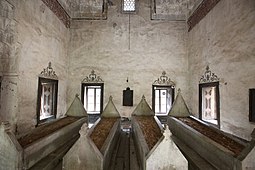|
Gülruh Hatun
Gülruh Hatun (Ottoman Turkish: کل رخ خاتون, "Rose face", dead on 3 June 1528), also known as Gülendam Hatun (Ottoman Turkish: کل اندام خاتون, "Rose soul"),[1] was a concubine of Sultan Bayezid II of the Ottoman Empire. Early lifeHer origin is unknown, but the consorts of the Ottoman sultans were by custom normally concubines who came to the Ottoman Imperial harem via the Ottoman slave trade.[2] Gülruh entered in Bayezid's harem at Amasya. With Bayezid she had two children, a daughter, Kamerşah Sultan, who married Mustafa Pasha[3] and a son, Şehzade Alemşah born in 1466.[4] Accompanying AlemşahAccording to Turkish tradition, all princes were expected to work as provincial governors as a part of their training. In 1490, Alemşah was sent to Menteşe, and later in 1502 to Manisa, and Gülruh accompanied him.[5] She played an anxious role in protecting her son from manipulation by members of his princely entourage and to ensure that the Sultan regarded the latter, and not the prince or herself, as responsible for the reports he had received about Alemşah's misconduct.[6] She responded to the Sultan's instruction that she took to the conduct of her son. She presented her case against seven members of her son's suite, including his tutor, his doctor, and his preceptor, to whom she attributed responsibility for the problems. It was Alemşah's tutor in particular whom she blamed. She accused the tutor and his colleagues of inducing Alemşah to drink excessively so that he might be persuaded to sanction proposals against the law of Islam and the law of the Sultan.[7] Worried about Alemşah's ill health, she described his difficulty recovery from a month-long bout unable to bear any longer the corruption of these evil doers, she called the tutor shortcomings to the Sultan's attention, among them the squandering of the prince's treasury to the extent that even she had not received her stipend for a year. But the tutor had dismissed her protest as the work of the chief eunuch of the prince's private household, and unjustly denounced the latter to the Sultan.[8] Gülruh Hatun implored the Sultan to remove them. She concerned not only for the precariousness of her son's physical and political condition but also for the preservation of her own rights and status.[8] IssueFrom Bayezid II, Gülruh had a daughter and a son:
CharitiesGülruh Hatun built a mosque and an endowment in Akhisar, a mosque in Aydın Güzelhisar and Duraklı Village, She built Hamams, rest house for travellers and another endowment was built in Gördes, Demirci, Nazilli, Birgi and Aydın Güzelhisan.[4] Last yearsAfter Alemşah's death in 1503,[5] she retired to Bursa, and died early in Suleiman the Magnificent's reign. She is buried in her own mausoleum located in Muradiye Complex, Bursa.[4][5] References
Sources
|
||||||||||||||





